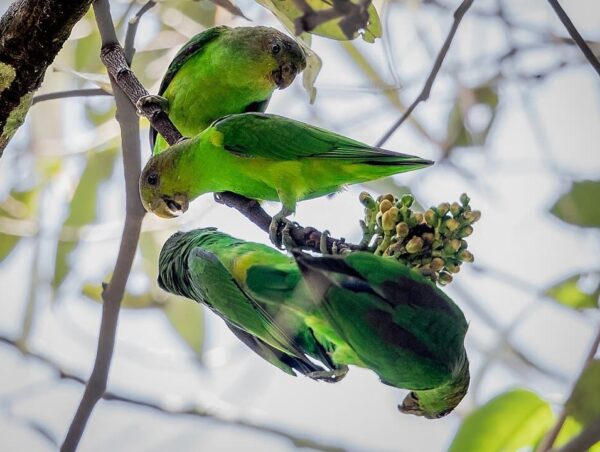Sapphire-rumped Parrotlet
Also known as:
Guiana Parrotlet
Also known as:
Guiana Parrotlet

Touit

purpuratus
Size:
17 cm (6.6 in)
Weight:
54-66 g (1.9-2.3 oz)
Subspecies including nominate:
two: T.p. purpuratus, T.p. viridiceps
Colour Adult:
T.p. purpuratus: Male-olive/brown crown and occiput; brownish tinge on ear coverts; dark brown, v-shaped band on scapulars and tertials; cobalt blue lower back and rump; violet/blue carpal edge; green underwing coverts; green central tail feathers tipped with black, with violet tipped, black margined lateral feathers. Beak olive/yellow with grey at base. Eye ring grey. Eye yellow//brown. Female-scapulars and tertials paler brown; lateral tail feathers banded with green before tips and black at tips; outer webs of lateral tail feathers missing black margins.
T.p. viridiceps: Both adults green crown, occiput and nape.
Colour Juvenile:
T.p. purpuratus: As in adult female, but in general duller in colour; olive/brown rump, with minimal or no blue feathers.
Call:
Calls are distinctive; in flight are nasal and hornlike. Also a three-syllable note series.
More Information:
Content Sources:
CITES
BirdLife International
Cornell Lab of Ornithology/Birds of the World
Parrots: A Guide to Parrots of the World, Juniper and Parr, 1998
Parrots of the World, Forshaw, 2006. 2010 edition
Lexicon of Parrots, Thomas Arndt.
Captive Status:
Uncommon but seen in several EU collections.
Longevity:
—
Housing:
Tall, planted aviary, minimum temperature 20 C (68 F).
Diet:
Fruits such as: banana, figs, oranges, apples, pears, tropical fruits, comprising 50 percent or more of diet; berries such as: mountain ash, blackberries, elder, pyracantha; lory food, commercial or homemade; vegetables such as: carrot, corn on the cob, celery, peas in the pod, green beans; green leaves such as: Swiss chard, lettuce, kale, dandelion, chickweed and sowthistle; half-ripe seeds; sprouted millet, canary grass seed, oats, barley and some sunflower; vitamin and mineral supplements.
Enrichment:
Provide lots of browse and plantings in aviary. Provide lots of places for this bird to hide.
Nest Box Size:
—
Clutch Size:
3-5
Fledging Age:
—
Hatch Weight:
—
Peak Weight:
—
Weaning Weight:
—
World Population:
Unknown, but reported as uncommon. Decreasing.
IUCN Red List Status:
Least Concern
CITES Listing:
Appendix II
Threat Summary:
Not globally threatened. Uncommon and never in large numbers, however, the species has a shy nature and may be under-recorded. Is projected to lose up to 15% of suitable habitat within its range over the next two decades; habitat loss may have already affected numbers. Appears to not be traded.
Range:
T.p. purpuratus: Guianas, N Brazil between Amapa and Sao Luis district, N Maranhao, west to lower Rio Negro in NE Amazonas, and S Venezuela, in SE Bolivar and S Amazonas, east of Cerro Duida.
T.p. viridiceps: Upper Rio Negro catchment in NW Amazonas, N Brazil, and west of Cerro Duida in S Amazonas, and S Venezuela, west to SE Colombia, south from Putumayo, W Caqueta and Rio Guaviare in Vaupes and Guainia, to NE Peru and E Ecuador.
Habitat:
Seen up to 1200 m (3936 ft) in lowland humid terra firme and varzea forest, savanna and more open woodland.
Wild Diet:
Feeds on fruits and Ficus figs, and Clusia grandiflora, Pouroma guianensis, Mauritia flexuosa and Astrocaryum aculeatum. Also trees of Sapotaceae and Myrtaceae, and in NE Peru recorded feeding on leaves, shoots and bark of Terminalia catappa (Combretaceae) and dead wood.
Ecology and Behaviour:
Are gregarious, generally seen in groups of 12-40 birds. Forages mainly in upper canopy but observed in lower bushes and occasionally on ground.
Clutch and Egg Size:
3-5 eggs.
Breeding Season:
March, Venezuela; April and November, Guianas; female excavating nest in November, Colombia. Nest is hollow in dead tree in flooded forest; arboreal termitaria also used.
Related Links:

![© Hector Bottai [CC BY-SA 4.0] Wikimedia Commons Wild Sapphire-rumped Parrotlets forage in a flowering tree](https://parrots.org/wp-content/uploads/1990/11/Sapphire-rumped-Parrotlet-Hector-Bottai-CC-BY-SA-4.0-via-Wikimedia-Commons-e1732747618740-100x100.jpg)